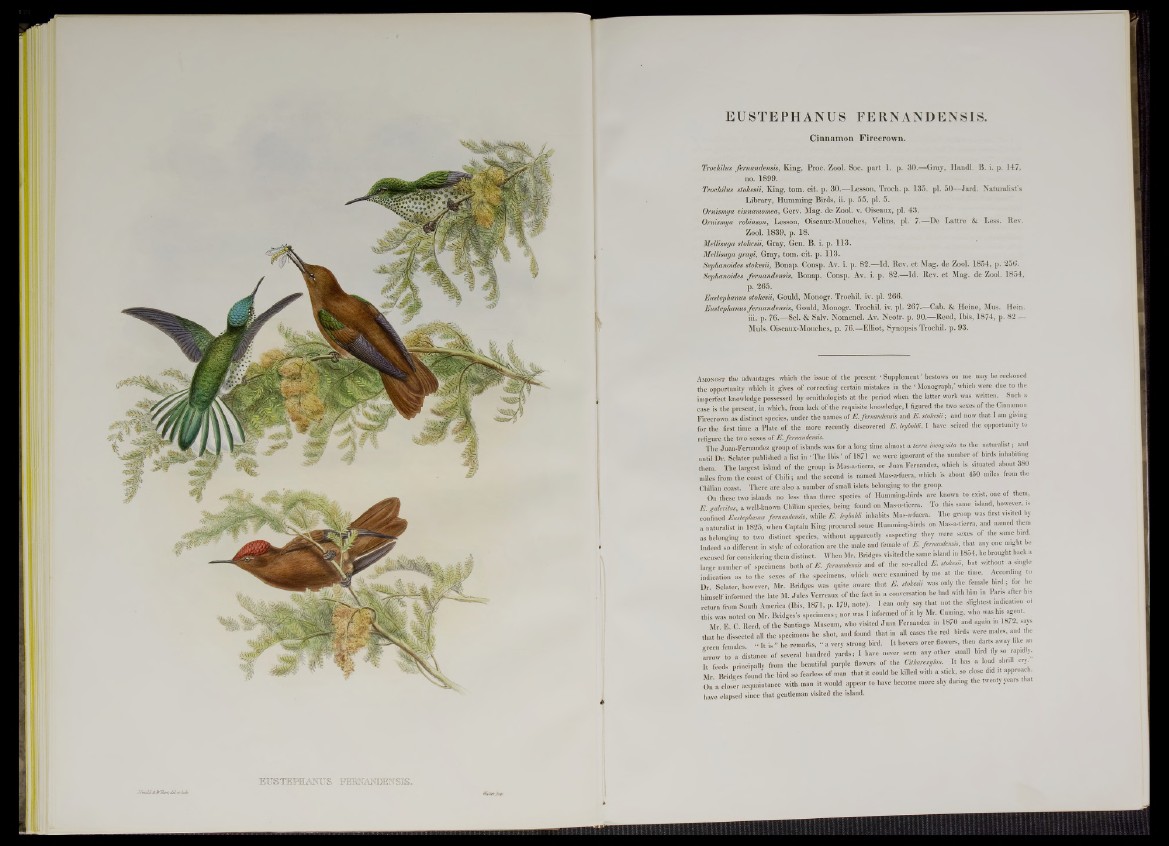
JGoukL&H'Bart’.deiet-hih'
EUSTEPHANUS FERNANDENSIS.
tiihlurjmp.
EUSTEPHANUS FERN AN DEN SI S.
Cinnamon Firecrown.
Trochilns fern an d enm , King, Proc. Zool. Soc. part 1. p. 3 0 .— Gray, Handl. B. i. p. 147,
no. 1899.
Trochilus stokesii, King, tom. cit. p. 3 0 .— Lesson, Troch. p. 135. pi. 5 0—Jard. Naturalist’s
Library, Humming Birds, ii. p. 5 5 , pi. 5.
Ornismya cinnamomea, Gerv. Mag. de Zool. v. Oiseaux, pi. 4 3 .
Oi'nismya robinson, Lesson, Oiseaux-Mouclies, Velins, pi. 7 .— De Lattre & Less. Rev.
Zool. 1 8 3 9 , p. 18.
Mellimga stokesii, Gray, Gen. B. i. p. 1 1 3 .
Mellisuga grayi, Gray, tom. cit. p. 113.
Sephanoides stokesii, Bonap. Consp. Av. i. p. 8 2 .— Id. Rev. e t Mag. de Zool. 1854, p. 256.
Sephanoides fe rn a n d enm , Bonap. Consp. Av. i. p. 8 2 .— Id. Rev. et Mag. de Zool. 1854,
p. 2 65.
Eustephanus stokesii, Gould, Monogr. Trochil. iv. pi. 2 66.
Eustephanus fernandensis, Gould, Monogr. Trochil. iv. pi. 2 6 7 .—Cab. & Heine, Mus. Hein.
iii. p. 7 6 .— Scl. & Salv. Nomencl. Av. Neotr. p. 90 .— Reed, Ibis, 1874, p. 8 2 —
Muls. Oiseaux-Mouches, p. 7 6 .—Elliot, Synopsis Trochil. p. 93.
Amongst the advantages which the issue of the present ‘ Supplément’ bestows on me may be reckoned
the opportunity which it gives of correcting certain mistakes in the ‘ Monograph,’ which were due to the
imperfect knowledge possessed by ornithologists at the period when the latter work was written. Such a
case is the present, in which, from lack of the requisite knowledge, I figured the two sexes of the Cinnamon
Firecrown as distinct species, under the names o f E. fernandenm and E. stokesii ; and now that I am giving
for the first time a Plate o f the more recently discovered E. leyboldi, I have seized the opportunity to
refigure the two sexes of E. fernandensis.
The Juan-Fernandez group of islands was for a long time almost a terra incognita to the naturalist; and
until Dr. Sclater published a list in ■ The Ibis ' of 1871 we were ignorant of the number of birds inhabiting
them. The largest island of the group is Mas-a-tierra, or Juan Fernandez, which is situated about 380
miles from the coast of Chili ; and the second is named Mas-a-fnera, which is about 450 miles from the
Chilian coast. There are also a number of small islets belonging to the group.
On these two islands no less than three species of Humming-birds are known to exist, one of them,
E galeritas, a well-known Chilian species, being found on Mas-a-tierra. To this same island, however, is
confined Eustephanm fernandenm, while E . Icjtoldi inhabits Mas-a-fuera. The group was first visited by
a naturalist in 1825, when Captain King procured some Homming-birds on Mas-a-tierra, and named them
as belonging to two distinct species, without apparently suspecting they were sexes of the same bird.
Indeed so different in style o f coloration are the male and female of E. fernandenm, that any one might be
excused for considering them distinct. When Mr. Bridges visited the same island in 1854, he brought back a
large number o f specimens both of E. fernandensis and of the so-called E. stokem, but without a single
indication as to the sexes o f the specimens, which were examined by me at the tune According to
Dr. Sclater, however, Mr. Bridges was quite aware that E. stokesii was only the female bird ; for he
himself informed the late M. Jules Verreaux of the fact in a conversation he had with him m Paris after his
return from South America (Ibis, 1871, p. 179, note). I can only say that not the slightest indication of
this was noted on Mr. Bridges's specimens; nor was I informed of it by Mr. Cuming, who was his agent.
Mr E C Reed o f the Santiago Museum, who visited Juan Fernandez in 1870 and again in 187-, says
that he dissected all the specimens he shot, and found that in all cases the red birds were males, and the
green females 1 It is ” he remarks, 1 a very strong bird. It hovers over flowers, then darts away like an
arrow to a distance of several hundred yards; I have never seen any other small bird fly so rapidly.
It feeds principally from the beautiful purple flowers o f the Citkarexylon. It has a loud shrill cry^
Mr Bridges found the bird so fearless of man that it could be killed with a stick, so close did it approach
On a closer acquaintance with man it would appear to have become more shy during the twenty years
have elapsed since that gentleman visited the island.